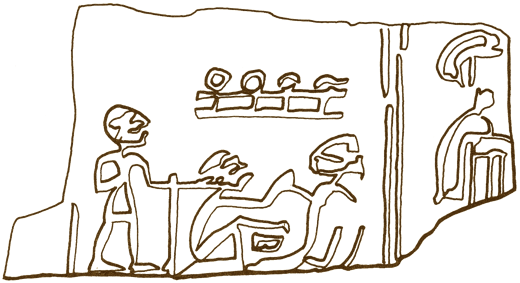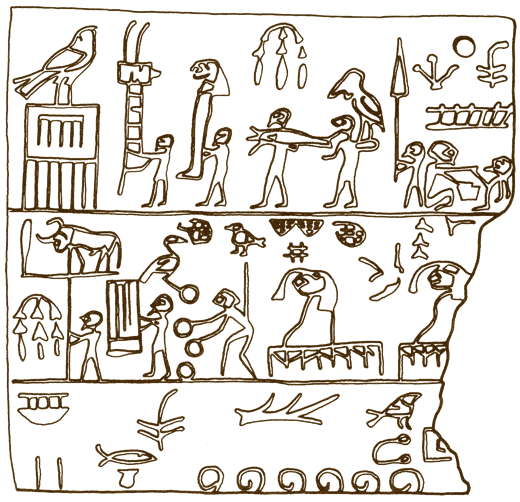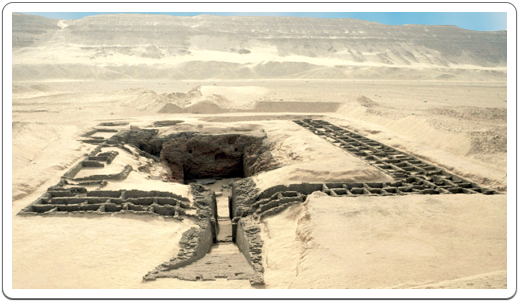When examining human sacrifice, the three following practices should be distinguished:
- The ritual killing of human beings as part of the offerings presented to the gods on a regular basis, or on special occasions.
- Retainer sacrifice, or the killing of domestic servants to bury them along with their master.
- The killing of convicted criminals or enemies of the country. Although criminals and enemies of the country may have been killed in a ritualised manner, this practice cannot be considered as real human sacrifice. It is therefore not discussed here.
The ritual sacrifice of humans
There is some evidence that suggests that human sacrifice was practised during the Predynastic Period and at the beginning of the 1st Dynasty.
The earliest known example of human sacrifice may perhaps be found in Predynastic burials in the south of Egypt, dated to the Naqada II Period. One of the discovered bodies showed marks of the throat having been cut before decapitation took place.
A fragmentary label from the reign of Horus Aha found at Abydos, and a label dated to the time of Aha's successor, Djer, found at Saqqara, may bear witness to a ritual involving the killing of a human being. In both cases a kneeling figure sticks a long weapon into the chest of a bound victim sitting in front of him. A bowl between the assailant and his victim may have been intended to catch the latter's blood as he bleeds to death. Also present in both cases is some kind of fence-like sign, drawn above the sacrificial scene.
On the label fragment from Aha, a figure of authority, identified by his long stick, observes the killing. Behind the victim, a fetish, that at least in later periods was associated with Anubis, is represented. It is not known if this fetish may have been related to the practice of human sacrifice.

A fragmentary label from the time of the Horus Aha holds the oldest piece of evidence of human sacrifice in Ancient Egypt.
Source: Wilkinson, Early Dynastic Egypt, p. 267, fig. 1.
The context of representation on Djer's label involves ritual objects being presented to the name of the king. The killing of a human being appears to be part of the ritual, which would exclude the possibility that we are witnessing the ritual killing of a prisoner. The purpose of the entire ritual and its connection with human sacrifice are, however, unknown.

A label from the reign of the Horus Djer also shows the killing of a human being in a seemingly ritual context (top row, to the right).
Source: Wilkinson, Early Dynastic Egypt, p. 267, fig. 2.
There is no evidence for this kind of human sacrifice after the reign of Djer, so it is possible that this practice may have been abandoned during the early 1st Dynasty.
Retainer sacrifice
At the royal cemetery of Umm el-Qa'ab, the tombs of the 1st Dynasty kings from Aha to Qa'a are accompanied by subsidiary burials. These burials are arranged in rows or blocks either extending from the royal tomb, as was the case with Aha, or surrounding it. The position of the subsidiary tombs compared to the royal tomb is believed to reflect the relationship of their occupants to the king during life.
Several tombs were found to contain skeletal remains. The analysis of some remains found in the subsidiary graves of Aha's tomb has shown that none of the individuals buried there was older than 25 years. This suggests that each of them may have been chosen to be buried along with the king.
From the time of Djet onwards, the owners of the subsidiary tombs would often be identified. Exceptionally, their name was painted in red ink on the south wall of their grave, but mostly it would be inscribed on a small stela that was placed in the tomb. This identification sometimes included a title. Thus we learn that a “royal sealbearer" was buried adjacent to Qa'a.
The most elaborate stela, also found in a grave next to Qa'a's burial chamber, belonged to a man named Sabef. On the stela, he is represented standing and holding a long stick, the usual posture of a high official . From his titulary, we see that he was “Keeper of the Tomb" of Qa'a and of the palace. He was also a priest and “Keeper of the Secrets and Decrees", a confident of the king.
Some of the people in the tombs next to their king were thus not nameless, anonymous people but individuals with a very distinct relationship to the king. At least a number of them were high officials.

The tomb of Den at Umm el-Qa’ab was surrounded by 136 subsidiary tombs.
The superstructure covering the tombs of Semerkhet and Qa'a also appears to have covered the subsidiary burials. At least in this case it is obvious that the subsidiary burials occurred at the latest at the same time as the royal burial. This can either mean that all of the subsidiary burials predated the royal burial, or that they occurred at the same time. In the latter case, the tomb of Semerkhet would be the earliest known hard evidence of retainer sacrifice.
In view of the evidence presented here, it is not unlikely that, excluding Narmer, all kings of 1st Dynasty chose members of their household and staff, to be buried with them. It is, however, somewhat surprising that some of them held high offices during their lives.
The way they were put to death is not clear, as no trace of a violent death appears to have been found on their skeletal remains. At least it is certain that, contrary to some popular belief, they were not buried alive.
The burial of servants along with their master was abandoned at the beginning of the 2nd Dynasty, when a new royal cemetery, at Saqqara, was preferred to the one at Umm el-Qa'ab. The practice itself may perhaps have survived in a more symbolic way, when, starting from the Old Kingdom, statues representing working people and servants were placed in tombs.